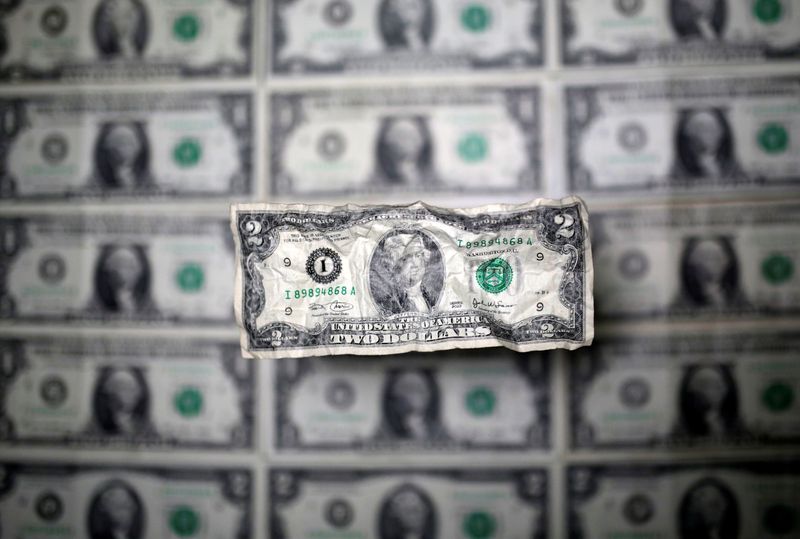Forex
Dollar steady ahead of Fed Chair remarks, underpinned by higher US yields


© Reuters. U.S. dollar banknote is seen in this picture illustration taken May 3, 2018. REUTERS/Dado Ruvic/Illustration/File photo
By Brigid Riley and Alun John
TOKYO (Reuters) – The dollar held firm against major currencies on Thursday and gained against more volatile ones, underpinned by the U.S. 10-year yield nearing the 5% level and before remarks by Federal Reserve Chair Jerome Powell at a discussion on the economy.
The , which tracks the unit against six main peers, was at 106.5 steady on the day, having risen 0.33% on Wednesday.
Its moves were more dramatic against currencies that are particularly exposed to swings in global growth expectations, with the Australian dollar and New Zealand dollars each down as much as 0.6%. The New Zealand currency hit its lowest level in a year of $0.5815.
The British pound, also traditionally more vulnerable to global swings, was down 0.2% at $1.2118 while the euro was 0.1% firmer at $1.05515. Neither currency was far from multi-month lows hit in early October.
“Over the last day or so, the spike higher in yields has hurt risk sentiment in markets, we saw a sell off overnight in global equity markets and that risk-off trading is driving FX markets particularly in the high-beta commodity currencies,” Lee Hardman, senior currency analyst at MUFG, said.
“Other majors have been more stable, even as yields continue to move higher. Maybe there is some caution ahead of Powell later in the day.”
Both long and short-dated U.S. yields hit 16-year highs on Thursday, with selling pushing the 10-year yield to almost 5%, a psychologically significant level. European and Japanese bonds were also under pressure. [US/] [GB/] [JP/] [GVD/EUR]
Powell will participate in a discussion on the economic outlook at the Economic Club of New York at 1600 GMT, a few days before the traditional quiet period ahead of the rate-setting Federal Open Market Committee meeting on Oct. 31-Nov. 1.
Prior to his remarks, policymakers appear to be agreement to hold interest rates unchanged at their next meeting, but uncertainty about what happens afterwards is high.
Other policymakers also face dilemmas. Japan is struggling with a weak yen, and Japan’s top currency diplomat said on Thursday that, although not acting in response to excessive currency moves could hurt the vulnerable, it would be better if they did not have to intervene.
The dollar was last at 149.82 yen, closing in on the psychologically significant 150 yen level that earlier this month triggered a sharp sudden strengthening for the yen, although analysts say the indications suggest Japan did not intervene.
Dollar/yen could be pushed higher depending on whether U.S. yields continue to rise at a faster pace than their Japanese peer yields, Carol Kong, currency strategist and economist at the Commonwealth Bank of Australia (OTC:), wrote in a note.
“The implication is the risk of FX intervention by the BoJ remains high in our view,” said Kong.
The yen, a traditional safe haven, has not benefited much from risk aversion due to the war in the Middle East, unlike the Swiss franc, which has strengthened sharply.
The euro was last steady against the franc at 0.9471 though hit a one-year low of 0.9449 francs the day before.

 Forex3 years ago
Forex3 years agoForex Today: the dollar is gaining strength amid gloomy sentiment at the start of the Fed’s week

 Forex3 years ago
Forex3 years agoUnbiased review of Pocket Option broker

 Forex3 years ago
Forex3 years agoDollar to pound sterling exchange rate today: Pound plummeted to its lowest since 1985

 Forex3 years ago
Forex3 years agoHow is the Australian dollar doing today?

 Cryptocurrency3 years ago
Cryptocurrency3 years agoWhat happened in the crypto market – current events today

 World3 years ago
World3 years agoWhy are modern video games an art form?

 Commodities3 years ago
Commodities3 years agoCopper continues to fall in price on expectations of lower demand in China

 Economy3 years ago
Economy3 years agoCrude oil tankers double in price due to EU anti-Russian sanctions























